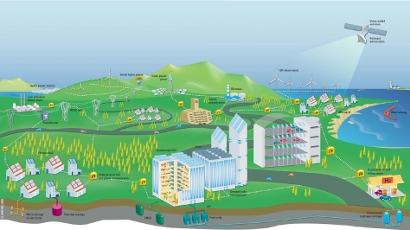Smart Grid Simulation

Energy grid revolution is at our doorstep. Which techniques and theories can be applied to it? Is there a role for space control and monitoring? At this project a future electricity network is modelled and studied as a complex adaptive system.
Overview of smart grids
Today’s grids are predominantly based on large central power stations connected to high voltage transmission systems which, in turn, supply power to medium and low-voltage local distribution systems. The transmission and distribution systems are commonly run by natural monopolies (national or regional bodies) under energy authorities’ control. In contrast, the generation sector is increasingly competitive. The overall picture is still one of power flow in one direction from the power stations, via the transmission and distribution systems, to the final customer. Architecture and technology approach in many cases the age of one century.
Current grids have served well but will not be adequate in the future: grids must ensure secure and sustainable electricity supplies, take advantage of new technologies and comply with new policy imperatives and changing business frameworks. Today’s central generation has to be combined with distributed generation (DG) and renewable energy sources (RES) and the grid will need to be flexible to demand response and demand side management (DSM). Distribution grids will become active and will have to accommodate bi-directional power flows. The liberalisation of electricity markets is also an important factor to take into account as it can bring the benefits of competition, choice and incentives for an efficient development. These objectives refer to the electricity networks of the future towards 2020 and beyond, which are already the object of much research and development in Europe and the US.
The smart grid is a relatively new concept for electricity networks, serving as an umbrella term that covers the aforementioned objectives and the relevant technology under development. A smart grid is an electricity network that can intelligently integrate the actions of all users connected to it - generators, consumers and those that do both – in order to efficiently deliver sustainable, economic and secure electricity supplies. A smart grid can employ intelligent monitoring, control, communication, and self-healing technologies. Some of its benefits would be:
- possibility to reduce power consumption at consumer side during peak hours (Demand side management);
- facilitating grid connection of distributed generation power (with photovoltaic arrays, small wind turbines, micro hydro, or even combined heat power generators in buildings);
- grid energy storage for distributed generation load balancing;
- improved reliability against many different component failure scenarios (in contrast to today's catastrophic widespread power grid cascading failures).
An agent based approach
The complex interactions and interdependencies among participants in today’s and tomorrow’s competitive, decentralized electricity markets are similar to those studied in game theory. However, the nature of the power market is still too complex (e.g., repeated auctions, fluctuating supply and demand, non-storability of electricity, etc.) to be conveniently modelled by standard game theory techniques. In particular, the ability of market participants to repeatedly probe markets and adapt their strategies adds complexity that is difficult to represent with conventional techniques. The use of agent based models can reveal the emergent behaviour of the system, which is not inferred from the simple sum of the behaviour of its components but emerges from the interactions of the heterogeneous individual entities. Computational social science offers appealing extensions to traditional game theory.
Project description
In this project we focus on some aspects of a smart grid. An electricity network is modeled, where entities such as households or electricity distributors are individual agents. Agents are heterogeneous with bounded rationality and capable of making decisions. They can be producers or consumers, respectively interacting with the network. A competition game takes place under the terms of the electricity price and how it fluctuates depending on the demand, the offer and the forecasting. The forecasting is based on a space element, and the parameters of the forecast can be adjusted. Emphasis is given on the adaptivity of the system to different conditions and its ability to reach an equilibrium stable point where each entity can have a positive pay off. Different criteria on the stability of the system are examined. Finally elements such as the complexity of the electricity networks of the future and various input options (weather prediction errors, heavy loads) are being assessed
Links
- Distributed power grid management based on space technologies - ACT project
- European Technology Platform for the Electricity Networks of the Future *Agent-Based Computational Economics (ACE) Iowa state University
References
- V. S. Koritarov, "Modeling the Electricity Market as a Complex Adaptive System with an Agent-Based Approach", IEEE power & Energy magazine, July/August 2004